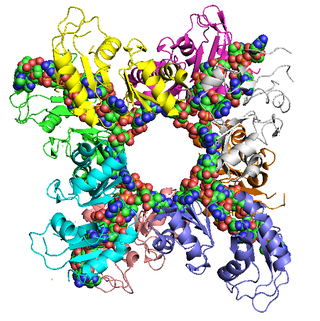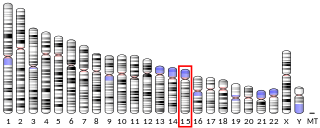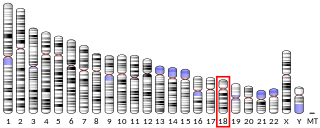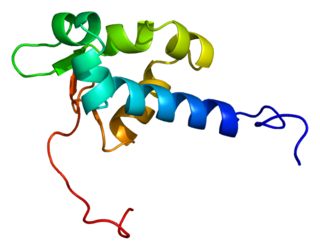
Poly(A)-binding protein is an RNA-binding protein which triggers the binding of eukaryotic initiation factor 4 complex (eIF4G) directly to the poly(A) tail of mRNA which is 200-250 nucleotides long. The poly(A) tail is located on the 3' end of mRNA and was discovered by Mary Edmonds, who also characterized the poly-A polymerase enzyme that generates the poly(a) tail. The binding protein is also involved in mRNA precursors by helping polyadenylate polymerase add the poly(A) nucleotide tail to the pre-mRNA before translation. The nuclear isoform selectively binds to around 50 nucleotides and stimulates the activity of polyadenylate polymerase by increasing its affinity towards RNA. Poly(A)-binding protein is also present during stages of mRNA metabolism including nonsense-mediated decay and nucleocytoplasmic trafficking. The poly(A)-binding protein may also protect the tail from degradation and regulate mRNA production. Without these two proteins in-tandem, then the poly(A) tail would not be added and the RNA would degrade quickly.

Polyadenylate-binding protein 1 is a protein that in humans is encoded by the PABPC1 gene. The protein PABP1 binds mRNA and facilitates a variety of functions such as transport into and out of the nucleus, degradation, translation, and stability. There are two separate PABP1 proteins, one which is located in the nucleus (PABPN1) and the other which is found in the cytoplasm (PABPC1). The location of PABP1 affects the role of that protein and its function with RNA.

Poly(rC)-binding protein 2 is a protein that in humans is encoded by the PCBP2 gene.

Eukaryotic translation initiation factor 4 gamma 1 is a protein that in humans is encoded by the EIF4G1 gene.

Polyadenylate-binding protein 2 (PABP-2) also known as polyadenylate-binding nuclear protein 1 (PABPN1) is a protein that in humans is encoded by the PABPN1 gene. PABN1 is a member of a larger family of poly(A)-binding proteins in the human genome.

Cold shock domain-containing protein E1 is a protein that in humans is encoded by the CSDE1 gene.

Eukaryotic translation initiation factor 4B is a protein that in humans is encoded by the EIF4B gene.

DNA-binding protein A is a protein that in humans is encoded by the CSDA gene.

Polyadenylate-binding protein 4 (PABPC4) is a protein that in humans is encoded by the PABPC4 gene.

Polyadenylate-binding protein-interacting protein 2 is a protein that in humans is encoded by the PAIP2 gene.

Eukaryotic translation initiation factor 4E type 2 is a protein that in humans is encoded by the EIF4E2 gene. It belongs to the eukaryotic translation initiation factor 4E family.

Polyadenylate-binding protein-interacting protein 1 is a protein that in humans is encoded by the PAIP1 gene.

Cytoplasmic polyadenylation element-binding protein 1 is a protein that in humans is encoded by the CPEB1 gene.

Eukaryotic peptide chain release factor GTP-binding subunit ERF3B is an enzyme that in humans is encoded by the GSPT2 gene.

Transcription initiation factor TFIID subunit 4B is a protein that in humans is encoded by the TAF4B gene.

La-related protein 4 is a protein that in humans is encoded by the LARP4 gene. LARP4 is an RNA-binding protein which consists of a La motif (LaM), RNA recognition motif (RRM) and a putative PABP binding motif. It has been shown that LARP4 is involved in mRNA stability.

Chromosome 14 open reading frame 102 is a 3810bp protein-encoding gene that is highly conserved among its non-distant orthologs. It contains 20 introns and 8 different RNAs - 7 splice variants and 1 unspliced form - and is located on the reverse strand of chromosome 14 (14q32.11). The protein encoded by this gene belongs to the UPF0614 family of Up-frameshift proteins and has a molecular weight of 132.417 kDa and isoelectric point of 7.88. It is expected to have a protein binding function and localization in the cytoplasm.

Pre-mRNA-processing factor 40 homolog B is a protein that in humans that is encoded by the PRPF40B gene.

Integrator complex subunit 1 is a protein that in humans is encoded by the INTS1 gene.

Poly(A) binding protein cytoplasmic 5 is a protein that in humans is encoded by the PABPC5 gene.






















